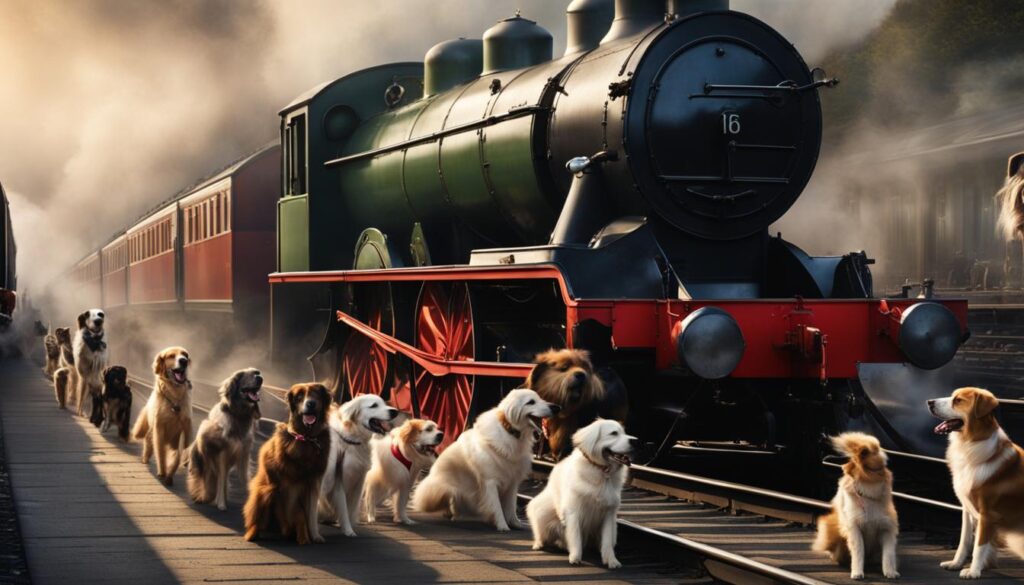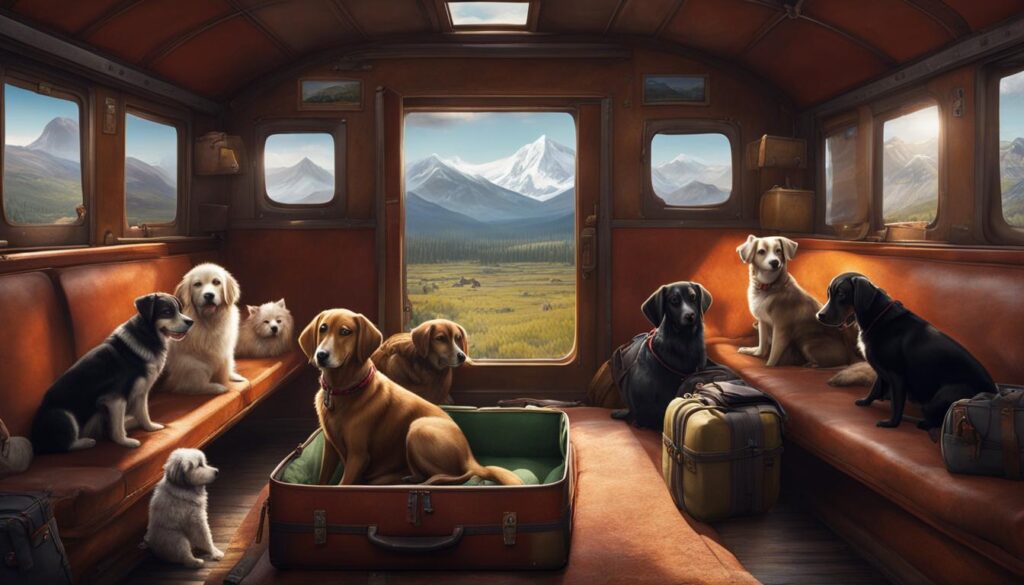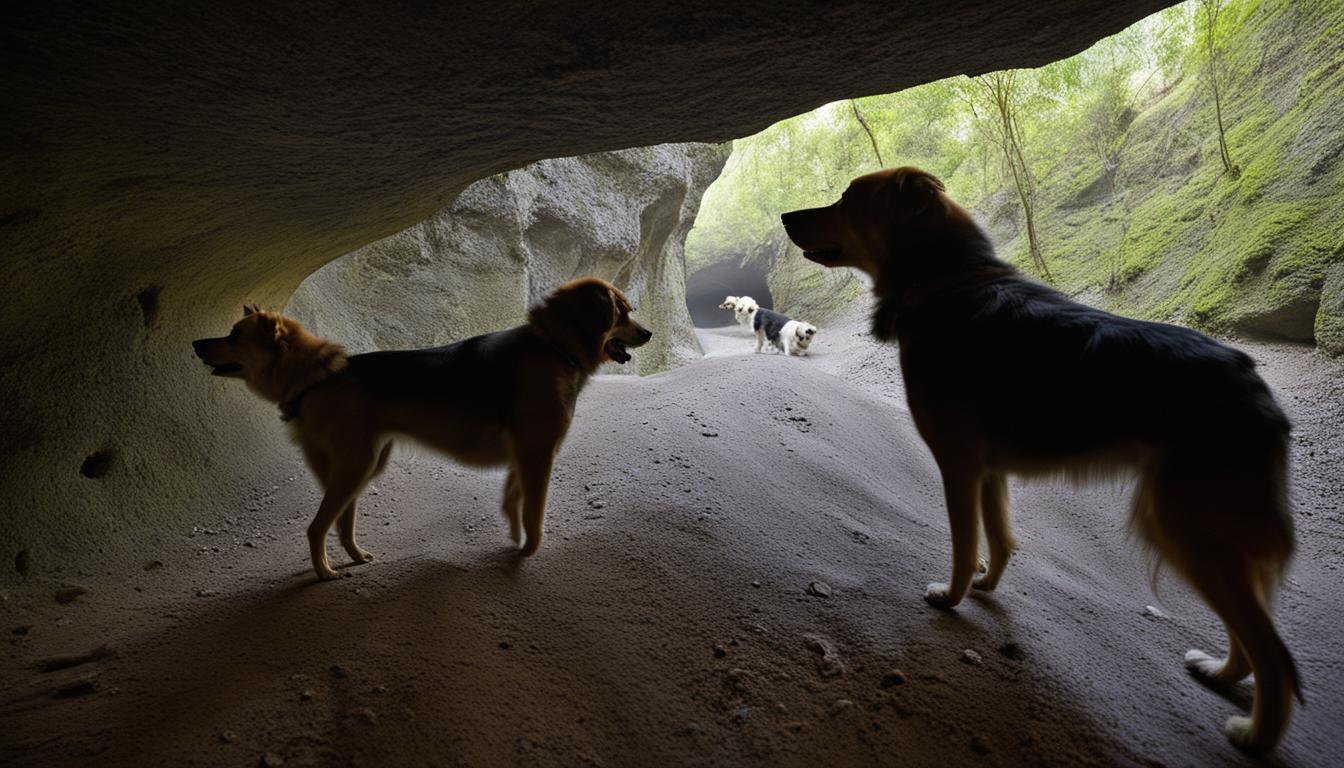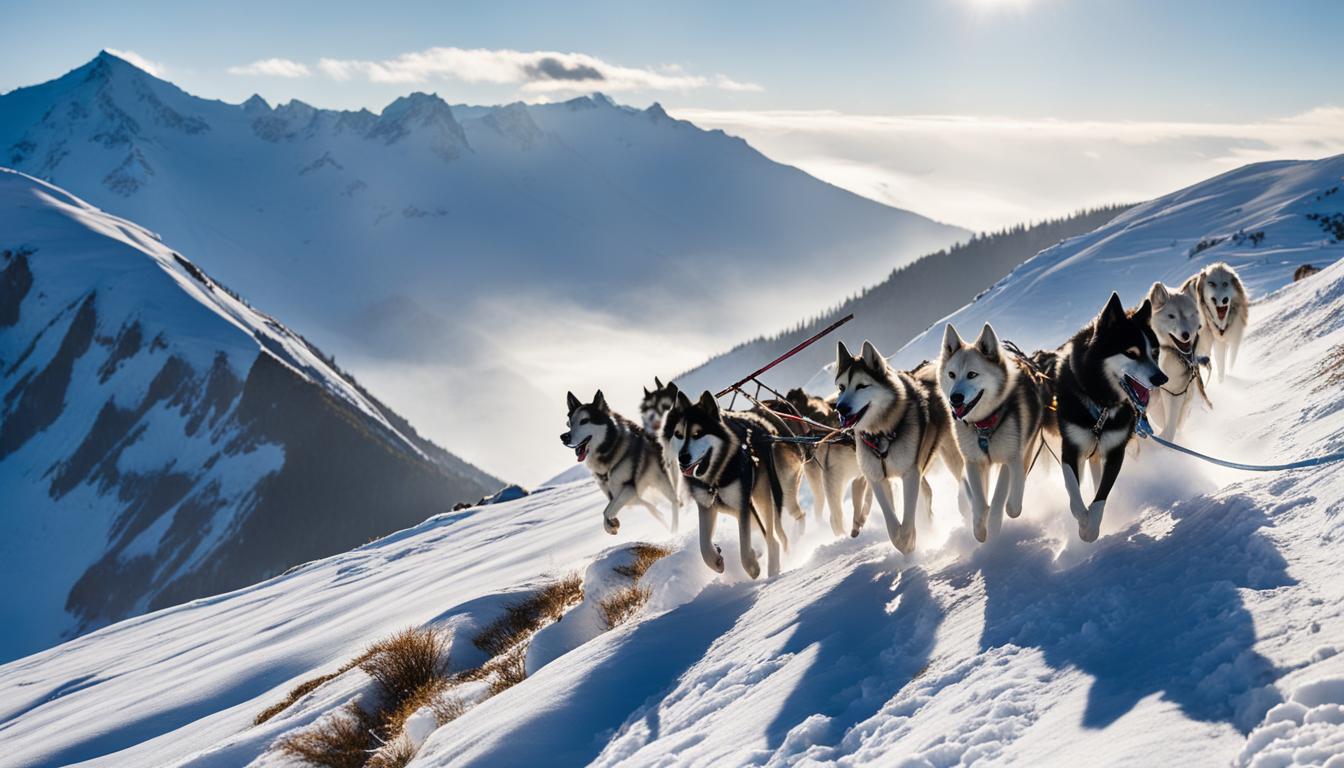Did you know that dogs have played a significant role in the exploration and development of railways throughout history? From the early days of train travel to the age of steam trains, these faithful companions have left an indelible mark on the railway industry. Let’s dive into the fascinating world of canines in railway history and discover their remarkable contributions.
Key Takeaways:
- Dogs have served as companions, protectors, and workers in railway exploration.
- They provided emotional support to railway workers during long and dangerous journeys.
- Dogs played a vital role in detecting and deterring potential dangers along railway routes.
- They have been valued as protectors in railway travel, aiding in construction and ensuring the safety of workers and passengers.
- In the era of steam trains, dogs acted as mascots, greeters, and detectors of equipment malfunctions.
Dogs as Protectors in Railway Travel
In the realm of railway travel, dogs have played an invaluable role as protectors and companions. These loyal canines have accompanied railway expeditions, offering much-needed emotional support to workers during long and arduous journeys. Their presence has been a source of comfort, providing a familiar face amidst the unpredictable and sometimes treacherous environments of early train travel.
But dogs’ contributions extend beyond companionship. They have also been essential in the construction of railway lines, aiding workers in various tasks. These intelligent creatures have been trained to carry small tools and supplies, assisting in the physical labor that goes into laying the tracks that connect cities and regions. Their reliability and alertness have made them essential assets, ensuring the safety and well-being of both railway workers and passengers alike.
The historical role of dogs in train journeys cannot be understated. From guarding against potential dangers along railway routes to providing a friendly and welcoming presence as station mascots, dogs have been dutiful protectors throughout the age of steam trains. Their unwavering loyalty and keen senses have contributed to the smooth operation and successful navigation of railway systems worldwide.
| Canine Contributions in Railway Travel | Protecting Workers and Passengers |
|---|---|
| Companionship and emotional support during long and challenging journeys | Detection and deterrence of potential hazards along railway routes |
| Assistance in the construction of railway lines, carrying tools and supplies | Alertness and loyalty in ensuring the safety of railway workers and passengers |
| Guiding engineers and surveyors in assessing potential routes for railway lines | Serving as station mascots, providing a friendly and welcoming presence to travelers |
As we delve deeper into the historical and present-day relationship between dogs and railways, it becomes clear that these loyal companions have left a lasting imprint on the world of train travel. Their contributions continue to be celebrated, as we recognize the unique tales and impacts that intertwine the histories of dogs and railways.

Canine Contributions to Railway Development
From the early days of railroad exploration, dogs have been an integral part of the development of railways. These loyal and intelligent creatures have played a vital role in assisting engineers and surveyors as they assessed potential routes for railway lines. Not only did dogs provide companionship during the arduous journeys, but they also acted as skilled guides, utilizing their keen senses to navigate challenging terrains.
Throughout history, dogs have proven to be invaluable assets in determining the feasibility and practicality of railway development in various regions. Their presence and assistance have helped uncover the most suitable paths for laying railway tracks. With their acute awareness and ability to detect potential dangers, dogs have contributed to creating safer and more efficient railway routes.
The contributions of dogs in early railroad exploration cannot be understated. They exemplify the strong bond between humans and animals, working together to forge new paths and drive progress. These canines played a pivotal role in shaping the railway industry, leaving a lasting legacy that is often overlooked but significant nonetheless.
| Canine Tasks in Railroad Exploration | Benefits to Railway Development |
|---|---|
| Guiding engineers and surveyors | Efficient assessment of potential routes |
| Alerting to potential dangers | Improved safety of railway operations |
| Providing emotional support | Boosting morale during challenging expeditions |
| Facilitating communication | Enhanced coordination among workers |
Dogs have left an indelible mark on the history of railway development. Their contributions have not only aided in the expansion of rail networks but also fostered a deeper appreciation for the bond between humans and animals in the pursuit of progress.
Dogs in the Age of Steam Trains
Dogs continued to play a significant role in railway operations during the era of steam trains. Their loyal and friendly nature made them excellent station mascots and greeters, providing a warm and welcoming presence to passengers.
These canine companions easily adapted to the bustling atmosphere of steam train stations, offering a sense of familiarity and comfort amidst the noise and commotion. They became beloved figures, known for their wagging tails and cheerful greetings, adding a touch of charm to the railway experience.
Aside from their role as greeters, dogs also served a practical purpose in ensuring the safe operation of steam trains. With their keen senses, they were trained to detect potential hazards such as overheated equipment or malfunctioning machinery. Their alertness and quick response helped prevent accidents and ensured the smooth functioning of the railways.

Throughout the age of steam trains, dogs proved themselves to be invaluable companions and guardians of railway operations. Whether it was their friendly presence at stations or their keen alertness in detecting potential dangers, canines made their mark in the history of steam train travel. Their contributions underscore the unique bond between dogs and railways, reminding us of the symbiotic relationship that has existed for centuries.
Canines in Railway Exploration Around the World
Dogs have played a vital role in railway exploration around the world, accompanying railway workers on expeditions to chart new routes and plan railway construction. These loyal and intelligent companions were well-suited for the task, offering their keen senses and agility to track wildlife, detect potential hazards, and provide emotional support along the way. The valuable contributions of dogs in these early train travels cannot be overstated.
Their presence not only helped boost morale and create a sense of camaraderie among the expedition teams but also facilitated the smooth operation of railway construction. Dogs were trained to navigate difficult terrains, making them indispensable guides for engineers and surveyors as they assessed potential routes for railway lines. Their assistance was crucial in determining the feasibility and practicality of railway development in various regions.
Dogs in Railway Exploration: Key Contributions
Let’s take a closer look at some of the key contributions made by dogs in railway exploration around the world:
- Tracking Wildlife: Dogs with their exceptional sense of smell and hearing played a crucial role in tracking and identifying wildlife along railway routes. By alerting workers to the presence of wild animals, dogs helped prevent potential accidents and ensured the safety of both railway workers and passengers.
- Detecting Hazards: With their acute senses, dogs were able to detect potential dangers such as unstable terrain, hidden obstacles, or even underground water sources. This early detection allowed for timely intervention and adjustments in the construction process, preventing potential disasters and ensuring the long-term stability of railway lines.
- Providing Emotional Support: The long and arduous journeys undertaken during railway exploration could be physically and emotionally exhausting. Dogs served as loyal companions, providing emotional support and alleviating the stress and isolation that railway workers often faced. Their unwavering presence offered comfort and a sense of familiarity, fostering a more positive and productive working environment.
In conclusion, dogs have made invaluable contributions to railway exploration around the world. Their loyalty, intelligence, and adaptability have not only facilitated the smooth operation of railway construction but also created a bond between humans and canines that transcends time. From tracking wildlife to detecting hazards and providing emotional support, dogs continue to leave an indelible mark on the history of railways.

Conclusion
Dogs have been your faithful companions in railway expeditions, providing unwavering support and companionship to you and your fellow workers. Whether it’s embarking on long and grueling journeys or undertaking the construction of railway lines, these remarkable canines have always been by your side.
Their intelligence and adaptability have made them indispensable in aiding in railway construction. From carrying small tools and supplies to detecting potential hazards, dogs have proven time and again that their loyalty knows no bounds.
In the earliest days of train travel, dogs played a crucial role in ensuring your safety and comfort. They provided emotional support during those long and sometimes treacherous expeditions, never failing to boost morale and create a sense of camaraderie among your team.
As we reflect on the rich history of dogs in early train travel, we can’t help but appreciate the unique bond that has formed between canines and railways. Their unwavering dedication and the tales of their extraordinary feats will forever be etched in the annals of railway exploration and development.
FAQ
How did dogs help in railway exploration and development?
Dogs played a significant role in railway exploration and development by providing companionship and emotional support to workers during long journeys. They also aided in the construction of railway lines, carrying small tools and supplies, and ensuring the safety of workers and passengers.
What tasks did dogs perform in railway travel?
Dogs accompanied railway expeditions, acting as guides and utilizing their keen senses to navigate difficult terrains. They were also employed as station mascots and greeters, providing a friendly presence to passengers and detecting potential hazards.
How did dogs contribute to the development of railways worldwide?
Dogs accompanied railway workers on expeditions to chart new routes and plan railway construction. They had specific tasks, such as tracking wildlife and alerting workers to potential dangers along the railway line. Their presence boosted morale and created a sense of camaraderie among the expedition teams.
What was the historical role of dogs in train journeys?
Dogs provided emotional support to railway workers during long and challenging journeys. They also assisted in the construction and operation of railway lines, leaving an indelible mark on the history of railways.





